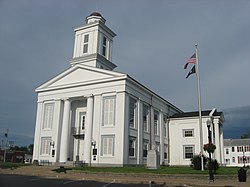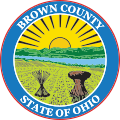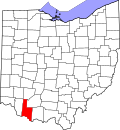2010 census
As of the 2010 United States census, there were 44,846 people, 17,014 households, and 12,379 families in the county. [23] The population density was 91.5 people per square mile (35.3 people/km2). There were 19,301 housing units at an average density of 39.4 units per square mile (15.2/km2). [24] The racial makeup of the county was 97.5% white, 0.9% black or African American, 0.2% Asian, 0.2% American Indian, 0.2% from other races, and 1.0% from two or more races. Those of Hispanic or Latino origin made up 0.6% of the population. [23] In terms of ancestry, 27.0% were German, 14.2% were Irish, 12.5% were American, and 9.7% were English. [25]
Of the 17,014 households, 34.5% had children under the age of 18 living with them, 55.7% were married couples living together, 11.2% had a female householder with no husband present, 27.2% were non-families, and 22.6% of all households were made up of individuals. The average household size was 2.60 and the average family size was 3.02. The median age was 39.9 years. [23]
The median income for a household in the county was $45,887 and the median income for a family was $54,184. Males had a median income of $39,049 versus $30,890 for females. The per capita income for the county was $20,167. About 9.0% of families and 12.4% of the population were below the poverty line, including 18.2% of those under age 18 and 8.4% of those age 65 or over. [26]
2000 census
As of the 2000 United States census, [27] there were 42,285 people, 15,555 households, and 11,790 families in the county. The population density was 86.3 people per square mile (33.3 people/km2). There were 17,193 housing units at an average density of 35.1 units per square mile (13.6/km2). The racial makeup of the county was 98.08% White, 0.92% Black or African American, 0.18% Native American, 0.13% Asian, 0.08% from other races, and 0.60% from two or more races. 0.44% of the population were Hispanic or Latino of any race. 29.5% were of American, 28.2% German, 10.7% English and 10.2% Irish ancestry.
There were 15,555 households, out of which 37.10% had children under the age of 18 living with them, 61.30% were married couples living together, 10.00% had a female householder with no husband present, and 24.20% were non-families. 20.20% of all households were made up of individuals, and 8.50% had someone living alone who was 65 years of age or older. The average household size was 2.69 and the average family size was 3.09.
The county population contained 27.60% under the age of 18, 8.10% from 18 to 24, 30.30% from 25 to 44, 22.40% from 45 to 64, and 11.60% who were 65 years of age or older. The median age was 35 years. For every 100 females there were 96.80 males. For every 100 females age 18 and over, there were 94.80 males.
The county's median household income was $38,303, and the median family income was $43,040. Males had a median income of $32,647 versus $22,483 for females. The per capita income for the county was $17,100. About 8.80% of families and 11.60% of the population were below the poverty line, including 15.20% of those under age 18 and 9.40% of those age 65 or over.






